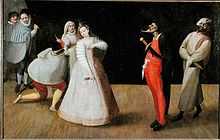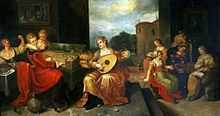Hieronymus Francken I
Hieronymus Francken I (ca. 1540, Herentals–1610, Paris) was a Flemish painter of the Antwerp school and an important member of the Francken family of artists.
Life

Hieronymus Francken I was born in Herentals as the son of Nicolaes Francken, a painter from Herentals.[1] His father later settled in Antwerp and was likely his first teacher.[2] His brothers Frans Francken I and Ambrosius Francken I both became successful painters. According to Karel van Mander, who referred to him three times using three different names, i.e. Ieroon Francken van Herenthals, Ieroon Vrancks, and Ieroon Franck, Francken was a pupil of Frans Floris.[3] It is unclear whether he traveled to Italy after his training in Antwerp. Such a trip is suggested by a work of his hand dated 1565 that depicts a scene from the Carnival of Venice (in the Suermondt-Ludwig-Museum in Aachen).[2]
From 1566 to 1572 he was in France where he was one of the masters employed to decorate the Palace of Fontainebleau.[4] Cornelis Floris, the Antwerp architect, sent his son to Paris in 1568 to train with Hieronymus Francken I.[2] In 1571 he returned to Antwerp to finish the Adoration of the Magi that had been left unfinished by Frans Floris when he died in 1570.[5] In 1574 he is documented in Antwerp.[6]
From 1578 until his death he lived in Paris and Fontainebleau, where he was appointed court painter to the French court in 1594.[6] He was the teacher of Abraham Bloemaert for a short time during Bloemaert's stay in Paris and Fontainebleau from 1581 to 1583.[7]
His daughter Isabella was a history and genre painter.[8]
Work

In addition to religious works, that were idealistic and fully in line with 16th-century taste, he also painted groups of dancers at the court. In these latter works he anticipates the development of this genre in the 17th century, especially in the work of his nephew Frans Francken II.[2] He also painted portraits and a self-portrait has been preserved.
His paintings are in an elegant Mannerist style and unite elements of the Antwerp, Italian (especially Venetian) and French styles, although the influence of Fontainebleau is the most pronounced.[5]
Family tree
| Francken family tree | ||||||||||||||||||||||||||||||||||||||||||||||||||||||||||||||||||||||||||||||||||||||||||||||||||||||||||||||||||||||||||||||||||||||||||||||||||||||||||||||||||||||||||||||||||||||||||||||||||||||||||||||||||||||||||||||||||||||||||||||||||||||||||||||||||||||||||||||||||||||||||||||||||||||||||||||||||||||||||||||||||||||||||||||||||||||||||||||||||||||||||||||||||||||||||||||||||||||||||||||||||||||||||||||||||||||||||||||||||||||||||||||||||||||||||||||||||||||||||||||||||||||||||||||||||||||||||||||||||||||||||||||||||||||||||||||||||||||||||||||||||||||||||||||||||||||
|---|---|---|---|---|---|---|---|---|---|---|---|---|---|---|---|---|---|---|---|---|---|---|---|---|---|---|---|---|---|---|---|---|---|---|---|---|---|---|---|---|---|---|---|---|---|---|---|---|---|---|---|---|---|---|---|---|---|---|---|---|---|---|---|---|---|---|---|---|---|---|---|---|---|---|---|---|---|---|---|---|---|---|---|---|---|---|---|---|---|---|---|---|---|---|---|---|---|---|---|---|---|---|---|---|---|---|---|---|---|---|---|---|---|---|---|---|---|---|---|---|---|---|---|---|---|---|---|---|---|---|---|---|---|---|---|---|---|---|---|---|---|---|---|---|---|---|---|---|---|---|---|---|---|---|---|---|---|---|---|---|---|---|---|---|---|---|---|---|---|---|---|---|---|---|---|---|---|---|---|---|---|---|---|---|---|---|---|---|---|---|---|---|---|---|---|---|---|---|---|---|---|---|---|---|---|---|---|---|---|---|---|---|---|---|---|---|---|---|---|---|---|---|---|---|---|---|---|---|---|---|---|---|---|---|---|---|---|---|---|---|---|---|---|---|---|---|---|---|---|---|---|---|---|---|---|---|---|---|---|---|---|---|---|---|---|---|---|---|---|---|---|---|---|---|---|---|---|---|---|---|---|---|---|---|---|---|---|---|---|---|---|---|---|---|---|---|---|---|---|---|---|---|---|---|---|---|---|---|---|---|---|---|---|---|---|---|---|---|---|---|---|---|---|---|---|---|---|---|---|---|---|---|---|---|---|---|---|---|---|---|---|---|---|---|---|---|---|---|---|---|---|---|---|---|---|---|---|---|---|---|---|---|---|---|---|---|---|---|---|---|---|---|---|---|---|---|---|---|---|---|---|---|---|---|---|---|---|---|---|---|---|---|---|---|---|---|---|---|---|---|---|---|---|---|---|---|---|---|---|---|---|---|---|---|---|---|---|---|---|---|---|---|---|---|---|---|---|---|---|---|---|---|---|---|---|---|---|---|---|---|---|---|---|---|---|---|---|---|---|---|---|---|---|---|---|---|---|---|---|---|---|---|---|---|---|---|---|---|---|---|---|---|---|---|---|---|---|---|---|---|---|---|---|---|---|---|---|---|---|---|---|---|---|---|---|---|---|---|---|---|---|---|---|---|---|---|---|---|---|---|---|---|---|---|---|---|---|---|---|---|---|---|---|---|---|---|---|---|---|---|---|---|---|---|---|---|---|---|---|---|---|---|---|---|---|---|---|---|---|---|---|---|---|---|---|---|---|---|---|---|---|---|---|---|---|---|---|---|---|---|---|---|---|---|---|---|---|---|---|---|---|---|
| ||||||||||||||||||||||||||||||||||||||||||||||||||||||||||||||||||||||||||||||||||||||||||||||||||||||||||||||||||||||||||||||||||||||||||||||||||||||||||||||||||||||||||||||||||||||||||||||||||||||||||||||||||||||||||||||||||||||||||||||||||||||||||||||||||||||||||||||||||||||||||||||||||||||||||||||||||||||||||||||||||||||||||||||||||||||||||||||||||||||||||||||||||||||||||||||||||||||||||||||||||||||||||||||||||||||||||||||||||||||||||||||||||||||||||||||||||||||||||||||||||||||||||||||||||||||||||||||||||||||||||||||||||||||||||||||||||||||||||||||||||||||||||||||||||||||
| Notes:
| ||||||||||||||||||||||||||||||||||||||||||||||||||||||||||||||||||||||||||||||||||||||||||||||||||||||||||||||||||||||||||||||||||||||||||||||||||||||||||||||||||||||||||||||||||||||||||||||||||||||||||||||||||||||||||||||||||||||||||||||||||||||||||||||||||||||||||||||||||||||||||||||||||||||||||||||||||||||||||||||||||||||||||||||||||||||||||||||||||||||||||||||||||||||||||||||||||||||||||||||||||||||||||||||||||||||||||||||||||||||||||||||||||||||||||||||||||||||||||||||||||||||||||||||||||||||||||||||||||||||||||||||||||||||||||||||||||||||||||||||||||||||||||||||||||||||
| Wikimedia Commons has media related to Hieronymus Francken (I). |
References
- ↑ Christa Grössinger, North-European panel paintings: catalogue of Netherlandish & German paintings before 1600 in English churches & colleges, Harvey Miller, 1992, p. 263
- ↑ 2.0 2.1 2.2 2.3 Hieronymus Francken I bij Oxford Art Online
- ↑ Ieroon Francken in Karel van Mander's Schilder-boeck, 1604 (Dutch)
- ↑ Ieroon Vrancks mentioned by Van Mander in Cornelis Ketel biography
- ↑ 5.0 5.1 Biographical details in the Larousse encyclopedia (French)
- ↑ 6.0 6.1 Hieronymus Francken I at the RKD (Dutch)
- ↑ Ieroon Franck mentioned by Van Mander in Abraham Bloemaert biography
- ↑ Isabella Francken, The Road to Calvary at Bonhams